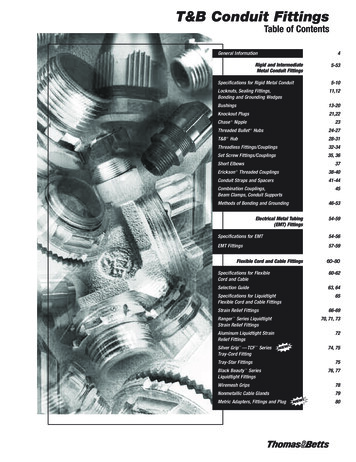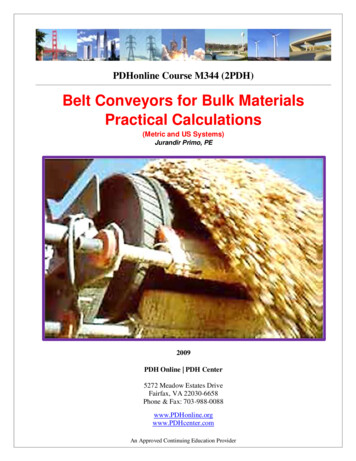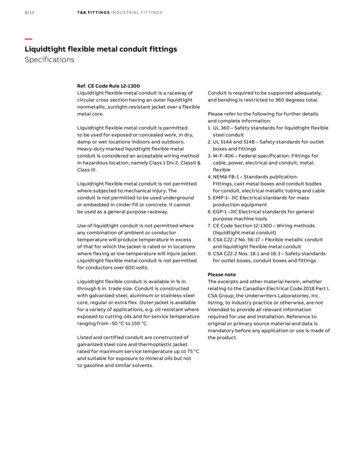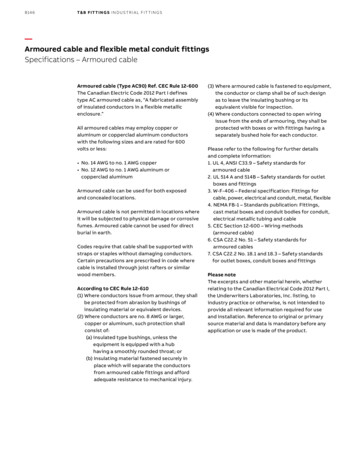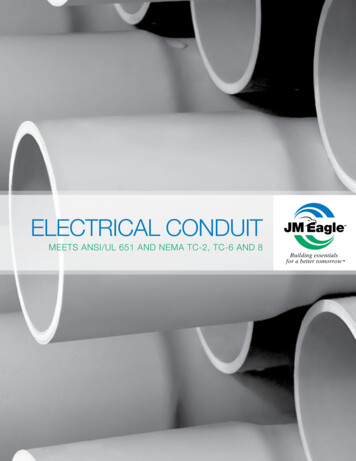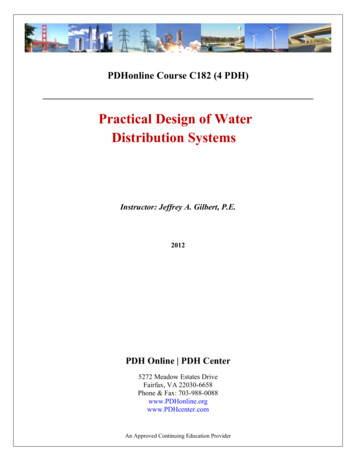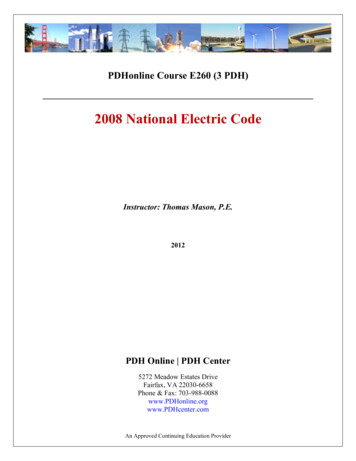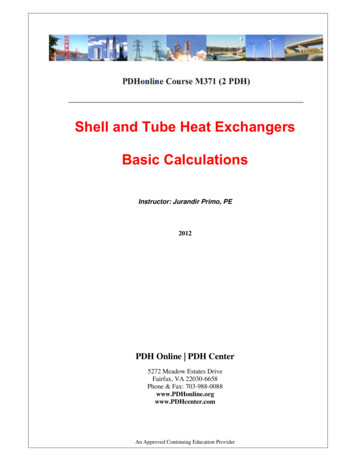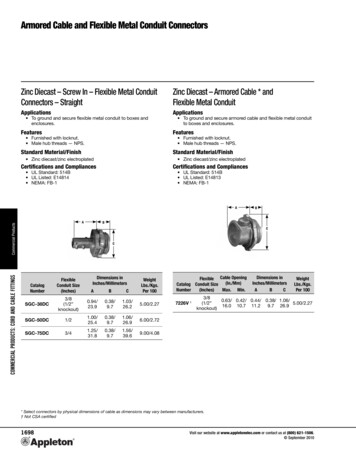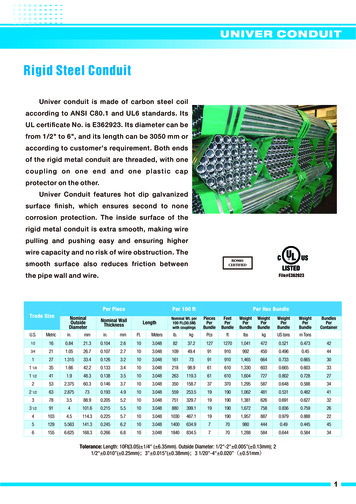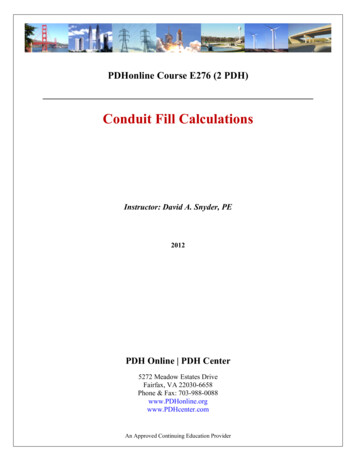
Transcription
PDHonline Course E276 (2 PDH)Conduit Fill CalculationsInstructor: David A. Snyder, PE2012PDH Online PDH Center5272 Meadow Estates DriveFairfax, VA 22030-6658Phone & Fax: 703-988-0088www.PDHonline.orgwww.PDHcenter.comAn Approved Continuing Education Provider
www.PDHcenter.comPDH Course E276www.PDHonline.orgConduit Fill CalculationsDavid A. Snyder, PEIntroduction:The purpose of this course is to explainconduit fill, which is just one of the factorsto be considered in conduit sizing. Thereare other aspects to be considered, as listedin the sidebar. Additional information isalso available in PDH Course E122Conduit System Design by Ralph Fehr,Ph.D, PE.The tables presented in this document areavailable as a separate file, if you havedifficulty reading the tables in thisdocument.These topics are not covered in this short course: Jam ratio – see FPN No. 2 to Table 1 inChapter 9 of the NEC. The de-rating of conductor ampacity basedon the number of current-carrying conductors inthe same conduit. Compact conductors (Table 5A in the NEC). Cable pulling tension. Conduit bending radius. Selecting the proper type of conduit andconductor for a given application. Sizing of boxes and conduit bodies. Sizing of wireways.One of the reasons to limit conduit fill isto allow air to circulate within the conduit and thereby permit some cooling of the conductors.Conduit fill calculations, also known as raceway fill calculations or conductor fill calculations,are performed to determine the minimum conduit size required for a given set of conductors.Drawings often describe a circuit as 3-#12, #12 Gnd, ¾” C., without mentioning the type ofconductors or the type of conduit. Typically, the construction specification is where theconductor type and conduit type are called out for each type of application. The reason we haveto know the type of conductor and conduit is because the physical dimensions are different fordifferent types of conductors and conduits. Different types of conductors with different types ofinsulation will have different outside diameters for the same wire size. See Figure 6 for thedifferent diameters of a 4/0 AWG conductor with four different insulation types. Table 5 fromChapter 9 of the NEC gives the approximate diameters and areas of different types ofconductors, a portion of which is presented as Table 7 in this document, which shows THHW,THHN, THWN, and XHHW. Different types of conduits will have different internal diametersfor the same conduit size. Table 4 from Chapter 9 of the NEC gives the nominal internaldiameters and cross-sectional areas for different conduit types and sizes. Portions of these valuesare reproduced in Tables 2 through 6 in this document for EMT, IMC, RMC, Schedule 40 PVC,and Schedule 80 PVC. See Figure 5 for an illustration of the different dimensions of a 1”conduit of these five different types.Conduit fill is often explained by using an example in which all of the conductors are the samesize and type. Sometimes, all of the conductors within a conduit are the same size (such as 12AWG) and type (such as THHN), but often the conductors will be of different sizes, andoccasionally there will be more than one type of conductor in the same conduit. Annex C in theNEC gives the maximum number of conductors of the same size that will be permitted in varioustypes and sizes of conduit. Annex C is based on the general case of all of the conductors beingthe same sizes and type, so Annex C has not been reproduced in this document, since we are David A. Snyder, Conduit Fill CalculationsPage 2 of 16
www.PDHcenter.comPDH Course E276www.PDHonline.orgconsidering specific cases in which the conductors might be different sizes and types. You canuse the techniques from this course to verify the values shown in Annex C, but be sure toconsider Note 7 to the tables in Chapter 9 of the NEC, as explained later.Occasionally, a circuit will run through more than one type of conduit. A common example ofthis is a circuit that runs in galvanized rigid steel (GRS, sometimes called RGS) above grade,then transitions to Schedule 40 PVC below grade, then back into GRS when it comes abovegrade again. The conduit fill calculations would be slightly different for the two types ofconduit.Conduit fill calculations are relatively simple and straightforward, but certain details must beknown about the conduit and the conductors. There can be only one unknown from thefollowing five pieces of information in order to perform the calculations to match the conduitsize with the conductors:¾ Size of conduit, such as 3”¾ Type of conduit, such as Schedule 40 PVC¾ Conductor quantities, such as 3-#12 THWN¾ Conductor sizes, such as 3-#12 THWN¾ Conductor types, such as 3-#12 THWN.For multiconductor cables, the last two topics listed above are replaced by using the overall oroutside diameter of the cable (it doesn’t matter what the sizes and types of the internalconductors are). This document will use different formats interchangeably to describe conductorsizes, such as #12 and 12 AWG. With regard to formulas and calculations in this document, wewill be using the asterisk (*) for multiplication and the forward slash (/) for division. Since wewill be discussing diameter (d), rather than radius (r), in this document, the familiar expressionfor the area of a circle will be shown as A π * d2 / 4, rather than A π * r2.Conduit Fill Tables from the NEC:NEC Table 1 in Chapter 9 gives guidelines for conduit fill, which are represented in Table 1 inthis document. David A. Snyder, Conduit Fill CalculationsPage 3 of 16
www.PDHcenter.comPDH Course E276www.PDHonline.orgIt might seem from a quick glance at Table 1 that the installation of 2 conductors is being treatedunfairly, since 2 conductors can only take up 31% of the conduit cross-sectional area while 3conductors can take up 40% of the area and 1 conductor can go all the way up to 53%. The lowvalue of 31% is based partly on geometry, as illustrated in Figure 2, where it is clear that 2conductors sized to take up a total of 53% of the conduit cross-sectional area won’t even fit inthe conduit. Similarly, 2 conductors sized at 40% fill would be pretty crowded in the conduitand might prove difficult to pull.A lesser-used conduit application is a nipple between two panels or enclosures, which is shownwith 60% fill in Tables 2 through 6. A nipple is a section of conduit that is 24” or less in lengthand is used to allow one or more cables to travel between boxes, cabinets, or similar enclosures.The conduit fill in these nipples is allowed to be up to 60% (obviously, this wouldn’t work fortwo conductors). This is Note 4 to the tables in Chapter 9 in the NEC, as described next.The notes to the tables in Chapter 9 are important, and some of them are paraphrased here:Notes to Tables in Chapter 9 of the NEC:(3) Equipment grounding conductors shall be included in conduit fill calculations.(4) Conduit nipples are permitted to be filled up to 60%.(5) For cables not included in the tables in Chapter 9, such as multiconductor cables, the actualdimensions of the cables shall be used in conduit fill calculations.(7) If all of the conductors are the same physical size (cross-sectional area), the next-higherwhole number can be used when the calculation results in a decimal remainder of 0.8 or larger.(9) A multiconductor cable shall be treated as a single conductor for calculating conduit fill. Forcables that have elliptical cross-sections, the cross-sectional area calculation shall be based onusing the major diameter (the longer dimension) of the ellipse as the circle diameter.Figures 1, 2, and 3, and 4 illustrate and compare conduit fill for 1, 2, 3, and 4, 5, & 6 conductors.The case of 60% fill for nipples is not included in these four illustrations.53% FillNEC Maximum40% FillAlso Okay31% FillAlso OkayOne ConductorFigure 1 David A. Snyder, Conduit Fill CalculationsPage 4 of 16
www.PDHcenter.comPDH Course E27653% Fill40% Fillwww.PDHonline.org31% FillNEC MaximumTwo ConductorsFigure 253% Fill40% FillNEC Maximum31% FillAlso OkayThree ConductorsFigure 340% FillNEC Maximum40% FillNEC Maximum40% FillNEC MaximumFour, Five, & Six ConductorsFigure 4Conduit Types:Electrical Metallic Tubing (EMT) as shown in Table 2 is thin-walled. When it is used, it istypically in protected locations, such as inside of hollow walls or above suspended ceilings. David A. Snyder, Conduit Fill CalculationsPage 5 of 16
www.PDHcenter.comPDH Course E276www.PDHonline.orgIntermediate Metal Conduit (IMC) as shown in Table 3 is called intermediate because it isbetween EMT and RMC in wall thickness and strength. IMC is sometimes used in place ofRMC, where approved.Rigid Metal Conduit (RMC) as shown in Table 4 could be either aluminum or galvanized rigidsteel (GRS) and has thicker walls than IMC. RMC is arguably the most popular all-purpose typeof conduit for above-grade (above-ground) conduit systems.Rigid Nonmetallic Conduit (RNC) Schedule 40 PVC as shown in Table 5 has thicker walls thanRMC, but it is made out of polyvinyl chloride (PVC), not metal. Schedule 40 PVC is often usedfor underground duct banks for telephone, data, and power. The wall thickness values in thistable are based on the average wall thickness, but many conduit catalogs show only the minimumwall thickness, which would give a different value for the internal diameter and area.Rigid Nonmetallic Conduit (RNC) Schedule 80 PVC as shown in Table 6 has thicker walls thanSchedule 40 PVC and the thickest walls of all of the conduit types discussed in this document.Schedule 80 PVC is often used for the riser to bring an electrical service underground from apole to below grade, which then goes to a building or a pad-mounted transformer. The wallthickness values in this table are based on the average wall thickness, but many conduit catalogsshow only the minimum wall thickness, which would give a different value for the internaldiameter and area.Outside Diameter 1.163"Wall Thickness 0.057"Internal Diameter 1.049"Internal Area 0.864 sq. in.1" EMTOutside Diameter 1.29"Wall Thickness 0.093"Internal Diameter 1.105"Internal Area 0.959 sq. in.Outside Diameter 1.315"Wall Thickness 0.126"Internal Diameter 1.063"Internal Area 0.887 sq. in.1" IMC1" RMCOutside Diameter 1.315"Wall Thickness 0.143"Internal Diameter 1.029"Internal Area 0.832 sq. in.1" Sch. 40 PVCOutside Diameter 1.315"Wall Thickness 0.19"Internal Diameter 0.936"Internal Area 0.688 sq. in.1" Sch. 80 PVCRelative Dimensions of Various 1" Conduit TypesFigure 5The cross-sectional area for each conduit is calculated from the internal diameter for that typeand size of conduit. The overall diameter and the thickness of the conduit wall are not importantfor conduit fill calculations, although they do determine the internal diameter, and have beenshown for reference on Tables 2 through 6. The rows are shaded as a visual aid. David A. Snyder, Conduit Fill CalculationsPage 6 of 16
www.PDHcenter.com David A. Snyder, Conduit Fill CalculationsPDH Course E276www.PDHonline.orgPage 7 of 16
www.PDHcenter.comPDH Course E276www.PDHonline.orgConductor Types:There are many types of insulated conductors. A few of the more common types will beconsidered in the document.THHW is rated at 75 C for wet locations and 90 C for dry locations and has no outer coveringon its insulation.THHN is rated at 90 C for dry and damp locations and has a nylon jacket over its insulation.THWN is rated at 75 C for dry and wet locations and has a nylon jacket over its insulation.XHHW is rated at 75 C for wet locations and 90 C for dry and damp locations and has no outercovering on its insulation.The type of conductor required is usually defined in the construction specifications and by thetype of installation – wet, damp, or dry. For example, wires installed in below-grade(underground) conduits must be rated for wet locations, since underground conduits will David A. Snyder, Conduit Fill CalculationsPage 8 of 16
www.PDHcenter.comPDH Course E276www.PDHonline.orginvariably contain water, eventually. THHN, therefore, is not suitable for below-grade conduitruns, since it is not rated for wet locations.Figure 6 shows that the diameters are slightly different for different types of conductors of thesame wire size or gage. In the case illustrated, XHHW is slightly thinner than THHN/THWN,which is a little thinner than THHW. The large outer circle in Figure 6 represents the outsidediameter of the conductor and the smaller circles inside represent the small strands of wire insideof the insulation. Looking at Table 7, THHN and THWN have matching diameters in all sizes.OutsideDiam. 0.688"OutsideDiam. 0.642"OutsideDiam. 0.638"THHWTHHN &THWNXHHWRelative Dimensions ofVarious 4/0 AWG Conductor TypesFigure 6Conductor type XHHW is not always thinner than conductor type THHN/THWN – it depends onthe wire size. Look at Table 7. In sizes 14 through 6 AWG, for example, XHHW is thicker thanTHHN/THWN. Table 7 in this document is based on Table 5 of Chapter 9 in the NEC. Therows are shaded as a visual aid.Conduit Fill Calculations:Let’s start with a simple example of 3-#10 (THHN) in a GRS conduit. These examples will befor conduit runs, not nipples, unless nipples are specifically mentioned.Find the minimum galvanized rigid steel (GRS) conduit size for 3-#10 (THHN).To calculate the minimum conduit size, we add up the cross-sectional areas of the conductorsfrom Table 7. We are dealing with THHN conductors, therefore:(3) * 0.0211 in2 0.0633 in2A Note About 1-1/4” (1.25”) Conduit:Some people might argue that 1-1/4” conduit is not astandard size, while others might disagree. If 1-1/4”conduit is not readily available, then 1-1/2” conduit isobviously the choice. The availability of 1-1/4” varieswith geographic location and has changed over theyears. David A. Snyder, Conduit Fill CalculationsPage 9 of 16
www.PDHcenter.com David A. Snyder, Conduit Fill CalculationsPDH Course E276www.PDHonline.orgPage 10 of 16
www.PDHcenter.comPDH Course E276www.PDHonline.orgSince we have three conductors, we can use up to 40% of the conduit fill, as shown in Table 1.We could either look at the 40% fill column in Table 4 for the smallest value greater than 0.0633in2, or calculate the 100% fill value by dividing 0.0633 in2 by 40%, such as:0.0633 in2 / 0.4 0.15825 in2, which is the minimum 100% conduit fill value.Using 0.15825 in2, we look at Table 4 in the 100% column and see that we could us a ½”conduit. Many construction specifications, however, limit the smallest conduit size to ¾”. If thatwere the case, we would have to choose ¾” conduit to match the construction specification, eventhough ½” meets the NEC requirement for conduit fill.Let’s try another example with two different wire sizes.Find the minimum Schedule 80 PVC conduit size for 3-500 KCMIL, 1/0 AWG Gnd, allconductors XHHW.Looking at Table 7 for XHHW conductors, we have:(3) * 0.6984 in2 2.0952 in2(1) * 0.1825 in2 0.1825 in2Adding together: 2.2777 in2Looking at the 40% column of Table 6 for Schedule 80 PVC, we find that we need a minimumconduit size of 3”.Consider another example.What would be the minimum size of Schedule 80 PVC for 3-8 AWG, 2-10 AWG, all THWN?(3) * 0.0366 in2 0.1098 in2(2) * 0.0211 in2 0.0422 in2Adding together: 0.152 in2Looking at the 40% column of Table 6 for Schedule 80 PVC, we find that we need a minimumconduit size of ¾”.What would be the minimum size of EMT for 2-8 AWG THWN?(2) * 0.0366 in2 0.0732 in2Since there are two conductors, we look at the 31% column from Table 2 and find that theminimum conduit size is ½”, but always check with the construction specification with regard tominimum conduit size. David A. Snyder, Conduit Fill CalculationsPage 11 of 16
www.PDHcenter.comPDH Course E276www.PDHonline.orgWhat would be the minimum size of Schedule 40 PVC for one 3/0 AWG ground XHHW?The overall area for an XHHW 3/0 AWG conductor is 0.2642 in2. Looking at the 53% columnin Table 5 for Schedule 40 PVC, we find that we need a minimum conduit size of ¾”.What would be the minimum size of Schedule 40 PVC for 5-3/0 AWG XHHW?(5) * 0.2642 in2 1.321 in2Look at the 40% column of Table 5. Does this mean that we have to go up to 2-1/2” Sch. 40conduit, since 2” Sch. 40 conduit only provides 1.316 in2? Since all of the conductors are thesame physical size, we might be able to use Note 7 to the tables in Chapter 9 of the NEC, whichsays we can round up the number of conductors permitted if we come up with a decimalremainder of 0.8 or more. Therefore, looking at 2”:1.316 in2 / 0.2642 in2 4.98 conductorsNote 7 says we can round this value up to 5 conductors, so 2” Schedule 40 PVC conduit wouldmeet the NEC requirements for conduit fill.Would the outcome of the above example be the same for Schedule 80 PVC?The 40% column of Table 6 for 2” Schedule 80 PVC tells us that the allowable conduit fillwould be 1.15 in2, which is less than the value of 1.321 in2 that we calculated for the sameconductors in Example 6. Can we use Note 7 to the tables in Chapter 9? Let’s see:1.15 in2 / 0.2642 in2 4.35 conductorsSince the decimal remainder of 4.35 is 0.35, we can’t use Note 7, which specifies a minimumdecimal remainder of 0.8. What size Schedule 80 conduit would we need? To accommodate the1.321 in2 of conductors, Table 6 says we need a 2-1/2” conduit.Let’s say that there is an existing 1-1/2” Schedule 40 PVC conduit running below grade(underground) between two buildings. How many 12 AWG XHHW conductors can be placed inthis existing conduit while meeting the NEC maximum conduit fill limitation?Assuming three or more conductors will fit, we look at the 40% column of Table 5 to see that1-1/2” Schedule 40 PVC can be filled up to 0.794 in2 for three or more conductors. The outsidediameter of one 12 AWG XHHW conductor is 0.0181 in2. Dividing the available area by thearea of one conductor gives us: David A. Snyder, Conduit Fill CalculationsPage 12 of 16
www.PDHcenter.comPDH Course E276www.PDHonline.org0.794 in2 / 0.0181 in2 43.867 conductors.Since all of the conductors are the same size, Note 7 allows us to round this number up to 44conductors.Let’s look at an example with a nipple used to run wires between two panels.What size GRS nipple would be required for 6-4/0 AWG XHHW, 2-6 AWG THHN Gnd?(6) * 0.3197 in2 1.9182 in2 [XHHW](2) * 0.0507 in2 0.1014 in2 [THHN]Adding together: 2.0196 in2Looking at the 60% column of Table 4 for Rigid Metal Conduit (RMC), we find that we need aminimum conduit size of 2”. Since the conductors are different diameters, there is no need toconsider using Note 7.A multiconductor cable, which has multiple insulated conductors within a common jacket, istreated as a single conductor for the purpose of conduit fill calculations. Notes 5 and 9 to thetables in Chapter 9 of the NEC mention multiconductor cables specifically.Consider a 5/C #14 tray cable, as illustrated in Figure 7, for the next example.Five 14 AWG Conductors,Individually InsulatedSeven StrandsPer ConductorOuter JacketOutside Diameter 0.39"Cross-Sectional Area PI * (0.39)² / 4 0.119 sq. in.Multiconductor 5/C #14 THHN/THWNTray Cable (Type TC)Figure 7What size GRS conduit would be required for one 5/C #14 tray cable?One cable is 0.119 in2 and the 53% column of Table 4 says ½” conduit would meet the conduitfill requirement.What size Schedule 80 PVC conduit would be required for two 5/C #14 tray cables? David A. Snyder, Conduit Fill CalculationsPage 13 of 16
www.PDHcenter.comPDH Course E276www.PDHonline.orgTwo cables would be 2 * 0.119 in2 0.238 in2. It might seem that the 31% column of Table 6tells us that 1-1/4” conduit would be required, but let’s see if we can use Note 7, since both of thecables are the same physical size. The 31% column of Table 6 at 1” says we have 0.213 in2 towork with, and if we divide that by the area of one cable we get 0.213 in2 / 0.119 in2 1.79which can be rounded up to 1.8, since that is all the accuracy that we need. Therefore, 1”conduit would meet the maximum conduit fill.How many 5/C #14 tray cables would fit in a 2” galvanized rigid steel (GRS) conduit?Assuming more than two cables will fit, a 2” GRS (RMC) conduit has a 40% area of 1.363 in2(from Table 4), and the cross-sectional area of one cable is 0.119 in2, therefore:1.363 / 0.119 11.5, so the answer is 11.How many 5/C #14 tray cables would fit in a 2” aluminum nipple running from one box toanother?A 2” aluminum (RMC) conduit has a 60% area of 2.045 in2 (from the 60% column for nipples onTable 4), and the cross-sectional area of one cable is 0.119 in2, therefore:2.045 / 0.119 17.2, so the answer is 17.0.179"Nonmetallic-sheathed (NM) cable is also known as Romex cable. This type of multiconductorcable is used in a large percentage of residential wiring and is typically run without conduit. Inthe following examples, we will consider a 2-conductor with ground NM cable because of itselliptical cross-section (see Figure 8) and examine how that would affect conduit fillcalculations. Note 9 to the tables in Chapter 9 of the NEC says that we have to use the majordiameter (0.41”) to calculate the circle to get the cross-sectional area of π * (0.41)2 / 4 0.132 in2for this type of cable.NEC Cross-Sectional Area PI * (0.41)² / 4 0.132 sq. in.0.41"Solid Copper ConductorWhite-Insulated (Neu.)Paper-Insulated (Gnd)Black-Insulated (Hot)12/2 Nonmetallic-Sheathed ConductorType CU-NM-B or Romex SIMpull Figure 8 David A. Snyder, Conduit Fill CalculationsPage 14 of 16
www.PDHcenter.comPDH Course E276www.PDHonline.orgIn one way, it makes sense to use the longer diameter of the ellipse to calculate the crosssectional area, since we won’t be able to control which way the long and short diameters will beoriented as the cable twists through the conduit.What size Schedule 40 PVC conduit would be required for one 12/2 NM cable?One NM cable has an NEC cross-sectional area of 0.132 in2. Looking at the 53% column ofTable 5 indicates that a ½” conduit at 0.151 in2 would meet the NEC requirement for conduit fill.Even though ½” conduit would meet this requirement, it would actually be difficult to pull thisjacketed solid-conductor cable through any ½” conduit fittings. To re-state this, ½” conduitwould meet the NEC requirements, but it would make everyone’s life easier to use ¾” or largerconduit, since this is solid wire, not stranded.What size Schedule 40 PVC conduit would be required for two 12/2 NM cables?The cross-sectional area for two cables would be 2 * 0.132 in2 0.264 in2. Looking at the 31%column of Table 5 might tell us that 1-1/4” conduit would be required, but let’s check to see ifNote 7 will allow us to use 1” conduit. The 1” 31% column of Table 5 says we have 0.258 in2 towork with, and if we divide that by the area of one cable, we get 0.258 in2 / 0.132 in2 1.95.Therefore, 1” conduit would meet the conduit fill requirement.What size IMC nipple would be required for two 5/C #14 tray cables and three 12/2 NM cables?The area of the two 5/C cables is 2 * 0.119 in2 0.238 in2The area of the three 12/2 NM cables is 3 * 0.132 in2 0.396 in2Adding the two areas together, 0.238 0.396 0.634 in2Looking at the 60% column of Table 3 indicates 1-1/4” conduit would meet the conduit fillrequirement. See Figure 9 for an illustration of this example. The conductors are not all thesame physical size, so there is no need to consider Note 7.Find the minimum aluminum conduit size for 3-500 KCMIL (XHHW), #3 Gnd (THHW).(3) * 0.6984 in2 2.0952 in2 [XHHW](1) * 0.1134 in2 0.1134 in2 [THHW]Adding together: 2.2086 in2Looking at the 40% column of Table 4 tells us that we need a 3” conduit. David A. Snyder, Conduit Fill CalculationsPage 15 of 16
www.PDHcenter.comPDH Course E276www.PDHonline.org(2) 5/C #14 & (3) 12/2 NM CablesIn 1-1/4" IMC NippleFigure 9In Closing:Conduit fill calculations are fairly simple, but they require a certain minimal amount ofinformation. If all of the conductors are the same size, Note 7 to the tables in Chapter 9 of theNEC might allow a smaller conduit size to be selected. Conduit fill calculations are only one ofmany factors to consider in sizing conduits.Abbreviations:5/C – Five-conductor cable.AWG – American Wire Gage.C.M. – Circular Mils – a measurement of cross-sectional area that is equal to the area of a circlethat is 0.001” (one mil) in diameter.EMT – Electrical Metallic Tubing.IMC – Intermediate Metallic Conduit.KCMIL – Thousand (K) circular (C) mil (MIL) – formerly known as MCM.MCM – Thousand (M) circular (C) mil (M) – now more-commonly known as KCMIL.NM – Nonmetallic-sheathed cable.NEC – National Electrical Code (NFPA 70) [the 2005 edition was used for this write-up].PVC – Polyvinyl Chloride, a type of conduit material that is often called plastic.RMC – Rigid Metal Conduit.RNC – Rigid Nonmetallic Conduit.THHN – Conductor type, see text.THHW – Conductor type, see text.THWN – Conductor type, see text.XHHW – Conductor type, see text.The author wishes to thank Joe Taylor, PE, for his time and invaluable input on this project.··· ·· —· —·—· · ·—· · David A. Snyder, Conduit Fill Calculations— ···· ·— —· —·— ···Page 16 of 16
Chapter 9 of the NEC. The de-rating of conductor ampacity based on the number of current-carrying conductors in the same conduit. Compact conductors (Table 5A in the NEC). Cable pulling tension. Conduit bending radius. Selecting the proper type of conduit and conductor for a given applic
